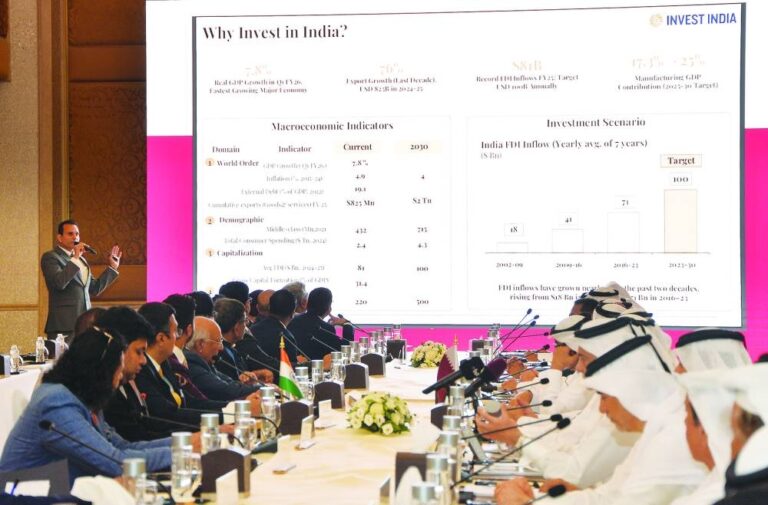India’s strategic investment partnership with Qatar has gained fresh momentum, with $52.9bn worth of commitments spanning 59 projects, according to a presentation by Invest India at the ‘Qatar-India Joint Business Council’ meeting earlier this month in Doha.
The basis for the type of financing required for public sector projects includes 14 hybrid projects amounting to $18.5bn, 12 equity projects worth $9.3bn, and nine debt-type projects to the tune of $23bn. The top three sectors for private projects are food processing with five projects, four in semiconductor and electronics, and three in pharmaceuticals and healthcare, the presentation stated.
According to Invest India, which is the country’s National Investment Promotion and Facilitation Agency, set up in 2009 as a not-for-profit company under the Department for Promotion of Industry and Internal Trade (DPIIT), a delegation from Qatar led by HE the Minister of State for Foreign Trade Affairs Dr Ahmed bin Mohammed al-Sayed visited India to lead a high-level delegation to discuss investment co-operation.
During the visit, stakeholders from both sides held many discussions and meetings at the government level, as well as the private sector level.
“Approximately $53bn of investment opportunities were shared across sectors; $50bn of the total amount comprised public sector projects, while the balance is for private sector projects. A lot of these projects are at the advanced stage. There is a good discussion happening between both sides when it comes to progressing these investments, and there are other projects that are also being looked at right now,” Invest India explained.
At the recent ‘Qatar-India Joint Business Council’ meeting, Invest India also outlined the South Asian country’s macroeconomic trajectory, highlighting its current status as the world’s fourth-largest economy with aspirations to reach third place by 2030.
Citing Prime Minister Narendra Modi’s vision, Invest India emphasised that India aims to become a $30tn developed economy by 2047, with a $7tn interim target set for 2030. The presentation framed India as a consumption-driven economy, with household spending accounting for over 60% of GDP, and gross capital formation — seen as a proxy for investment — averaging around 30%. It also noted that India’s FDI inflows have averaged $80bn annually over the past five years, with its share of global FDI doubling from 3% to 6% between 2014 and 2024.
The presentation also noted that repatriation of profits has increased, signalling investor confidence and India’s progress toward developed economy benchmarks. “It’s a sign of an economy that is progressing towards a developed economy, wherein investors have put money and are also able to take out the profits. Similarly, outside FDI is the investment of India’s companies… this also shows a healthy growth sign showing that Indian companies are growing in this nature and are also able to invest in other countries abroad,” Invest India pointed out.
India’s outbound FDI is also on the rise, with domestic firms investing abroad and raising $19bn through 80 IPOs in the Indian stock market in 2025 alone, according to Invest India. Green energy emerged as a key growth driver, with India achieving its 2030 target of 50% renewable installed capacity five years ahead of schedule. Out of the current 495GW total energy mix capacity, 248GW now comes from renewables (green/non-fossil energy capacity), with a new target of 500GW set for 2030.
“A lot of initiatives have been taken by both governments. India is a federal structure; there’s a government at the central level and there’s a government at the state level, so a lot of initiatives have been taken by governments at both levels to support investments into the country.
“A lot of these sectors have been re-licensed, except a couple of strategic ones. Most of the FDI is now allowed under the automatic route. The tech and royalty payments are also all on the automatic route. A lot of central government schemes and incentives are there,” Invest India also pointed out.
The presentation detailed a wide array of central and state-level incentives, including production-linked incentive schemes worth $24bn across 14 sectors, and state subsidies ranging from fixed capital support to full stamp duty exemptions. India’s logistics reforms were also spotlighted, with the ‘PM Gati Shakti’ initiative and a national logistics policy aimed at boosting multimodal connectivity.
Invest India emphasised that recent diplomatic exchanges have further strengthened bilateral ties. Following His Highness the Amir Sheikh Tamim bin Hamad al-Thani’s visit to India in February, a $10mn investment commitment was made, followed by Dr al-Sayed’s delegation in August. These engagements have led to the identification of approximately $53bn in investment opportunities, with hybrid financing models under discussion and several projects already at advanced stages.
The presentation also reaffirmed “India’s readiness” to welcome Qatari investors, citing sectoral diversity, policy stability, and a maturing industrial ecosystem as key enablers.
Images are for reference only.Images and contents gathered automatic from google or 3rd party sources.All rights on the images and contents are with their legal original owners.

